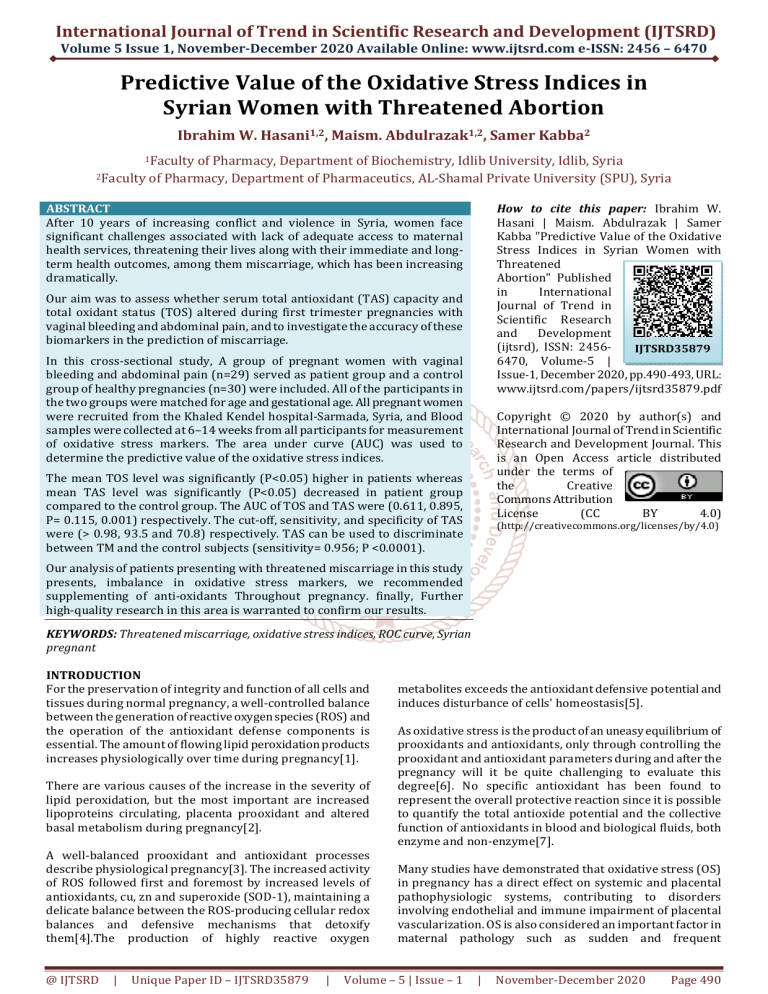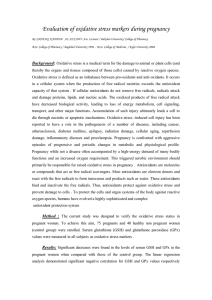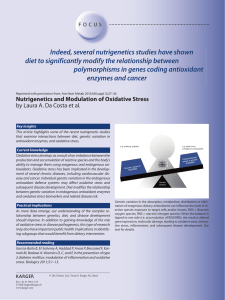
International Journal of Trend in Scientific Research and Development (IJTSRD)
Volume 5 Issue 1, November-December 2020 Available Online: www.ijtsrd.com e-ISSN: 2456 – 6470
Predictive Value of the Oxidative Stress Indices in
Syrian Women with Threatened Abortion
Ibrahim W. Hasani1,2, Maism. Abdulrazak1,2, Samer Kabba2
1Faculty
of Pharmacy, Department of Biochemistry, Idlib University, Idlib, Syria
2Faculty of Pharmacy, Department of Pharmaceutics, AL-Shamal Private University (SPU), Syria
How to cite this paper: Ibrahim W.
Hasani | Maism. Abdulrazak | Samer
Kabba "Predictive Value of the Oxidative
Stress Indices in Syrian Women with
Threatened
Abortion" Published
in
International
Journal of Trend in
Scientific Research
and
Development
(ijtsrd), ISSN: 2456IJTSRD35879
6470, Volume-5 |
Issue-1, December 2020, pp.490-493, URL:
www.ijtsrd.com/papers/ijtsrd35879.pdf
ABSTRACT
After 10 years of increasing conflict and violence in Syria, women face
significant challenges associated with lack of adequate access to maternal
health services, threatening their lives along with their immediate and longterm health outcomes, among them miscarriage, which has been increasing
dramatically.
Our aim was to assess whether serum total antioxidant (TAS) capacity and
total oxidant status (TOS) altered during first trimester pregnancies with
vaginal bleeding and abdominal pain, and to investigate the accuracy of these
biomarkers in the prediction of miscarriage.
In this cross-sectional study, A group of pregnant women with vaginal
bleeding and abdominal pain (n=29) served as patient group and a control
group of healthy pregnancies (n=30) were included. All of the participants in
the two groups were matched for age and gestational age. All pregnant women
were recruited from the Khaled Kendel hospital-Sarmada, Syria, and Blood
samples were collected at 6–14 weeks from all participants for measurement
of oxidative stress markers. The area under curve (AUC) was used to
determine the predictive value of the oxidative stress indices.
Copyright © 2020 by author(s) and
International Journal of Trend in Scientific
Research and Development Journal. This
is an Open Access article distributed
under the terms of
the
Creative
Commons Attribution
License
(CC
BY
4.0)
The mean TOS level was significantly (P<0.05) higher in patients whereas
mean TAS level was significantly (P<0.05) decreased in patient group
compared to the control group. The AUC of TOS and TAS were (0.611, 0.895,
P= 0.115, 0.001) respectively. The cut-off, sensitivity, and specificity of TAS
were (> 0.98, 93.5 and 70.8) respectively. TAS can be used to discriminate
between TM and the control subjects (sensitivity= 0.956; P <0.0001).
(http://creativecommons.org/licenses/by/4.0)
Our analysis of patients presenting with threatened miscarriage in this study
presents, imbalance in oxidative stress markers, we recommended
supplementing of anti-oxidants Throughout pregnancy. finally, Further
high-quality research in this area is warranted to confirm our results.
KEYWORDS: Threatened miscarriage, oxidative stress indices, ROC curve, Syrian
pregnant
INTRODUCTION
For the preservation of integrity and function of all cells and
tissues during normal pregnancy, a well-controlled balance
between the generation of reactive oxygen species (ROS) and
the operation of the antioxidant defense components is
essential. The amount of flowing lipid peroxidation products
increases physiologically over time during pregnancy[1].
There are various causes of the increase in the severity of
lipid peroxidation, but the most important are increased
lipoproteins circulating, placenta prooxidant and altered
basal metabolism during pregnancy[2].
A well-balanced prooxidant and antioxidant processes
describe physiological pregnancy[3]. The increased activity
of ROS followed first and foremost by increased levels of
antioxidants, cu, zn and superoxide (SOD-1), maintaining a
delicate balance between the ROS-producing cellular redox
balances and defensive mechanisms that detoxify
them[4].The production of highly reactive oxygen
@ IJTSRD
|
Unique Paper ID – IJTSRD35879
|
metabolites exceeds the antioxidant defensive potential and
induces disturbance of cells' homeostasis[5].
As oxidative stress is the product of an uneasy equilibrium of
prooxidants and antioxidants, only through controlling the
prooxidant and antioxidant parameters during and after the
pregnancy will it be quite challenging to evaluate this
degree[6]. No specific antioxidant has been found to
represent the overall protective reaction since it is possible
to quantify the total antioxide potential and the collective
function of antioxidants in blood and biological fluids, both
enzyme and non-enzyme[7].
Many studies have demonstrated that oxidative stress (OS)
in pregnancy has a direct effect on systemic and placental
pathophysiologic systems, contributing to disorders
involving endothelial and immune impairment of placental
vascularization. OS is also considered an important factor in
maternal pathology such as sudden and frequent
Volume – 5 | Issue – 1
|
November-December 2020
Page 490
International Journal of Trend in Scientific Research and Development (IJTSRD) @ www.ijtsrd.com eISSN: 2456-6470
miscarriages, preeclampsia, preterm labor, and other
conditions[8][9][10].
Recurrent pregnancy loss is characterized as three or more
successive spontaneous abortions before 20 weeks of
pregnancy are completed. This disease affects 0.5%-3% of
women during the menstrual cycle, it is estimated[11]. The
cause is not known in 50%-60% of cases involving recurrent
miscarriage, and this is why they are classed as idiopathic.
The implications for women may be significant psychological
distress and gynecological problems, in particular with
multiple miscarriages. Owing to the complexity of a
comprehensive understanding of their process, the topic of
idiopathic persistent error focuses continuously on doctors
with different specialties[12].
Placental oxidative stress may be a result of early pregnancy
that may lead to complications such as repeated abortions,
preeclampsia and congenital diabetes disorders. Oxidative
stress is expected to be a status in recurring pregnancy loss
(RPL) etiopathogensis[13].
system, discovered by Erel (Rel Assay Diagnostics®,
Gaziantep, Turkey). Under this process, iron-o-dianisidine
complex is oxidized into the ferric ions using oxidants in the
sample[14]. The results are given in a liter equivalent of
hydrogen peroxide (H2O2eqmicromol / L).
Absolute serum antioxidant status (TAS), assessed using a
modern automatic colorimetrical measurement (Rel Assay
Diagnostics ®, Gazyentep, Turkey). Find Erel's method. The
hydroxy radical reacted with the Fenton reaction using this
process to form a radical light-yellowish brow dianisyl
substratum with colorless o-dianisidine. The findings were
shown in Trolox as milli moles / liter equivalent
(TroloxEqmmol / L) for calculation[15]. Oxidative stress
index (OSI) was calculated by the ratio of TOS to TAS.
Urea, total proteins and albumin were determined by
commercial
assay
kit
(BiosystemSpain)
spectrophotometrically by a Biosystem BT 350as per
manufacturer's recommendations in serum samples.
After eight years of war and abuse in Syria, women face
major problems related to the lack of proper access to
reproductive health facilities and risk their life along with
immediate and long-term consequences, including
miscarriage. In this study, our aim was to determine the
markers of OS in patients with recurrent miscarriages and
comparing the level of OS with normal pregnancy, by
measuring total antioxidants (TAS) and total oxidative
status.
Statistical analysis:
Statistical analysis was performed using SPSS 21.0 for
Windows version. Independent samples t- test analysis was
applied normally distributed variables, while the Mann–
Whitney U test were applied for non-normally distributed
variables, and median (25 %–75 %) percentiles were
presented. finally a p value <0.05 was considered as
statistically significant. The area under curve (AUC) was
used to determine the predictive value of the oxidative stress
indices using MedCalc software.
Materials and methods
This study included a total of 55 pregnant women who have
been admitted to Khaled Kendel hospital, department of
Obstetrics and Gynecology, Sarmada, Syria. They were
concordant with participation in the study, which was
confirmed by their written consent in accordance with the
criteria of the Helsinki Declaration. The Research Ethics
Committee of Idlep University approved the study.
Results:
In the present study, patient and control groups were
compared and no significant difference was revealed in
terms of age (30.08±5.28 vs. 28.53±6.19, p= 0.394),
gestational weeks (10.28±2.44 vs. 11.26±2.49, p= 0.101),
urea levels (20.08±6.67 vs. 17.50±5.32, p= 0.125), albumin
levels (3.94±0.23 vs. 4.12±0.67, p= 0.198), and total proteins
levels (5.75±0.52 vs. 5.81±0.73, p=0.714).
The criteria for entry into the study were pregnancy
between the weeks of 11 and 12 and single tone pregnancy
(pathological and cytogenetic evidence of prior pregnancies
that no fetal defects or chromosome aberrations occurred)
and three previous spontaneous abortions (singles). Only
non-smokers were included in the study.
On the other hand, when we compared TAS, TOS and OSI
levels of the patient and the control groups, there were
significant differences between the groups. TAS levels
(median (25-75 percentile)) (mmol /L) were (0.68 (0.231.15) vs. 1.78 (1.36-2.14), p= 0.0001), TOS levels (µmol/L)
were (6.57 (5.06-8.18) vs. 4.07 (2.85-4.90), p= 0.0001) and
OSI levels were (11.28 (5.16-22.09) vs. 3.51 (2.30-4.85), p=
0.0001), respectively (Table 1).
Multiple births, polyhydramniotics, maternal diseases
(diabetes, asthma, obesity, preeclampsia, cardiac and renal
failure and infections of the urinary tract), fetal disease (fetal
delayed development) and local causes such as uterus and
vagina anatomical malformations, cervical inadequacies,
malignancies, alcohol, smoking or any drug use and other
diseases impacting the stage became the requirements for
exclusion.
5mlof venous blood samples were collected from the
participants; the serum samples were obtained by centrifuge
at 3000 RPM for 10 minutes and were eventually placed in
the eppendorf tubes and stored at-20˚C until analysis.
The total oxidant status (TOS) of serum was determined
with the use of a new automatic colorimetric measuring
@ IJTSRD
|
Unique Paper ID – IJTSRD35879
|
We demonstrated statistically significant decreased TAS
level in pregnant women who hada history of recurrent
pregnancy loss (p = 0.0001) (Fig. 1). We also observed
significantly increased TOS and OSI levels in patient groups
(p = 0.0001, separately) (Figs. 2, 3).
Receiver operating characteristic (ROC) curve analysis
demonstrated that TAS was the best indicator for
discriminating patients from controls with AUC, sensitivity,
specificity, positive protective value, negative protective
value (0.895, 0.93,0.70, 0.76, 0.93) respectively and cutoff
(>0.98) at (P= 0.0001)Fig. 4. While the AUC of TOS was 0.61
with sensitivity and specificity (0.71, 0.54) respectively at (P
=0.15) Fig. 5.
Volume – 5 | Issue – 1
|
November-December 2020
Page 491
International Journal of Trend in Scientific Research and Development (IJTSRD) @ www.ijtsrd.com eISSN: 2456-6470
Table 1: Oxidative stress markers values of studied groups:
Patient group (n= 25) Control group (n= 30)
Marker
Median (25-75%)
Median (25-75%)
TAS (mmol /L)
0.68 (0.23-1.15)
1.78 (1.36-2.14)
TOS (µmol/L)
6.57 (5.06-8.18)
4.07 (2.85-4.90)
OSI
11.28 (5.16-22.09)
3.51 (2.30-4.83)
Fig.1: Box blot of TAS levels (mmol/L) in patient and
control groups
P value
0.0001
0.0001
0.0001
Fig. 5: ROC curve for serum TOS in predicting of
patients from controls
Discussion:
Latest reports of early pregnancy loos, pre-eclampsia, and
hydatidiform mole complications indicate that these are the
findings of a typical pathophysiology. In first trimester the
abnormal placentation leads to oxidative stress and
subsequent endothelial dysfunction plays a vital role in the
development of pregnancy complications, such as
abortion[16][17][18].
Fig.2: Box blot of TOS levels (µmol/L) in patient and
control groups
Safronova et al. studied the generation of active oxygen
formed by blood granulocytes in women with a history of
habitual abortions (2–3 spontaneous abortions in the first
trimester, undeveloped pregnancies). In patients with a
history of loos repeated pregnancy relative to control group
with normal reproductive function, they observed that
development of active oxygen species in granulocytes could
be increased[19].
Vural et al[20] have been tested for the evaluation of
impaired antioxidant pathways by ascorbic acid, alpha
tocopherol, total thiol, ceruloplasmin, uric acid, albumin and
glutathione amounts. They found that defenses against
damaged antioxidants could cause recurring abortions;
recurring abortions could also lead to oxidative stress and
degradation and poor protection of antioxidants.
Fig. 3: Box blot of OSI levels in patient and control
groups
TAS
100
Sensitivity: 93.5
Specificity: 70.8
Criterion : >0.98
Sensitivity
80
60
40
20
AUC = 0.895
P < 0.0001
0
0
20
40
60
80
100-Specificity
100
Fig.4: ROC curve for serum TAS in predicting of
patients from controls
@ IJTSRD
|
Unique Paper ID – IJTSRD35879
|
Increased peroxidation in lipids and decreased in
antioxidant levels contrasted with the control group in
women with recurring pregnancy loos was found by Simsek
et al. [21]
El-Far M, etal.[22] evaluated the amounts of Glutathione,
glutathionereductase (GSH-R), glutathioneperoxidase
(GSHPX), catalase ( CAT), superoxide dismutase (SOD), oxide
nitric (NO) and malondialdehyde ( MDA), and TNF-alpha,
between the recurrent pregnancy loss and control group of
40 (20 females in their first trimesters and 20 females that
have been non-pregnant). They showed that antioxidant
protection is compromised and oxidative reactive species
increase together, which can contribute to recurring
abortion because of potential oxidative damage.
Volume – 5 | Issue – 1
|
November-December 2020
Page 492
International Journal of Trend in Scientific Research and Development (IJTSRD) @ www.ijtsrd.com eISSN: 2456-6470
In this study, levels of TOS and OSI, were significantly
increased while TAS levels were significantly decreased
among pregnant patients and control groups. The best
predictive value was for TAS to discriminate between
patients and control in cutoff (>0.98) at (P= 0.0001).
In our view, the rise in TOS and OSI levels and decreased in
TAS levels may be a result of repeated pregnancy loss
instead. If our use is justified, we will use this data for care or
if it is the result of calculating pregnancy risk.
References:
[1] K. H. Al-Gubory, P. A. Fowler, and C. Garrel, “The roles
of cellular reactive oxygen species, oxidative stress
and antioxidants in pregnancy outcomes,” Int. J.
Biochem. Cell Biol., vol. 42, no. 10, pp. 1634–1650, Oct.
2010.
[2]
F. Wu, F.-J. Tian, and Y. Lin, “Oxidative Stress in
Placenta: Health and Diseases,” Biomed Res. Int., vol.
2015, pp. 1–15, 2015.
[3]
D. Ardalić et al., “Lipid indexes and parameters of lipid
peroxidation during physiological pregnancy,” J. Lab.
Med., vol. 43, no. 2, pp. 93–99, Apr. 2019.
[4]
L. He, T. He, S. Farrar, L. Ji, T. Liu, and X. Ma,
“Antioxidants Maintain Cellular Redox Homeostasis
by Elimination of Reactive Oxygen Species,” Cell.
Physiol. Biochem., vol. 44, no. 2, pp. 532–553, 2017.
[5]
A. V. Snezhkina et al., “ROS Generation and
Antioxidant Defense Systems in Normal and
Malignant Cells,” Oxid. Med. Cell. Longev., vol. 2019, pp.
1–17, Aug. 2019.
[6]
[7]
I. D. Safronov, A. N. Trunov, and E. D. Kokareva,
“Prooxidant-Antioxidant Factors in the Blood of
Pregnant Women with Late Gestosis of Different
Severity,” Bull. Exp. Biol. Med., vol. 146, no. 6, pp. 800–
802, Dec. 2008.
J. M. Cohen, M. Beddaoui, M. S. Kramer, R. W. Platt, O.
Basso, and S. R. Kahn, “Maternal Antioxidant Levels in
Pregnancy and Risk of Preeclampsia and Small for
Gestational Age Birth: A Systematic Review and MetaAnalysis,” PLoS One, vol. 10, no. 8, p. e0135192, Aug.
2015.
[8]
K. Toboła-Wróbel, M. Pietryga, P. Dydowicz, M.
Napierała, J. Brązert, and E. Florek, “Association of
Oxidative Stress on Pregnancy,” Oxid. Med. Cell.
Longev., vol. 2020, pp. 1–12, Sep. 2020.
[9]
Z. Sultana, K. Maiti, J. Aitken, J. Morris, L. Dedman, and
R. Smith, “Oxidative stress, placental ageing-related
pathologies and adverse pregnancy outcomes,” Am. J.
Reprod. Immunol., vol. 77, no. 5, p. e12653, May 2017.
[10]
K. Duhig, L. C. Chappell, and A. H. Shennan, “Oxidative
stress in pregnancy and reproduction,” Obstet. Med.,
vol. 9, no. 3, pp. 113–116, Sep. 2016.
@ IJTSRD
|
Unique Paper ID – IJTSRD35879
|
[11]
A. J. Wilcox et al., “Incidence of Early Loss of
Pregnancy,” N. Engl. J. Med., vol. 319, no. 4, pp. 189–
194, Jul. 1988.
[12]
S. Gupta, A. Agarwal, J. Banerjee, and J. G. Alvarez,
“The Role of Oxidative Stress in Spontaneous
Abortion and Recurrent Pregnancy Loss: A Systematic
Review,” Obstet. Gynecol. Surv., vol. 62, no. 5, pp. 335–
347, May 2007.
[13]
M. H. Schoots, S. J. Gordijn, S. A. Scherjon, H. van Goor,
and J.-L. Hillebrands, “Oxidative stress in placental
pathology,” Placenta, vol. 69, pp. 153–161, Sep. 2018.
[14]
O. Erel, “A new automated colorimetric method for
measuring total oxidant status,” Clin. Biochem., vol. 38,
no. 12, pp. 1103–1111, Dec. 2005.
[15]
O. Erel, “A novel automated method to measure total
antioxidant response against potent free radical
reactions,” Clin. Biochem., vol. 37, no. 2, pp. 112–119,
Feb. 2004.
[16]
G. J. Burton and E. Jauniaux, “Placental Oxidative
Stress: From Miscarriage to Preeclampsia,” J. Soc.
Gynecol. Investig., vol. 11, no. 6, pp. 342–352, Sep.
2004.
[17]
M. Harma and M. Harma, “Defective placentation and
resultant oxidative stress play a similar role in
complete hydatidiform mole to that in preeclampsia
and early pregnancy loss,” Med. Hypotheses, vol. 66,
no. 1, pp. 100–102, Jan. 2006.
[18]
L. Poston and M. T. M. Raijmakers, “Trophoblast
Oxidative Stress, Antioxidants and Pregnancy
Outcome—A Review,” Placenta, vol. 25, pp. S72–S78,
Apr. 2004.
[19]
V. G. Safronova, N. K. Matveeva, N. V. Avkhacheva, V.
M. Sidel’nikova, L. V. Van’ko, and G. T. Sukhikh,
“Changes in Regulation of Oxidase Activity of
Peripheral Blood Granulocytes in Women with
Habitual Abortions,” Bull. Exp. Biol. Med., vol. 136, no.
3, pp. 257–260, Sep. 2003.
[20]
P. Vural, C. Akgül, A. Yildirim, and M. Canbaz,
“Antioxidant defence in recurrent abortion,” Clin.
Chim. Acta, vol. 295, no. 1–2, pp. 169–177, May 2000.
[21]
M. Simşek, M. Naziroğlu, H. Simşek, M. Cay, M.
Aksakal, and S. Kumru, “Blood plasma levels of
lipoperoxides, glutathione peroxidase, beta carotene,
vitamin A and E in women with habitual abortion.,”
Cell Biochem. Funct., vol. 16, no. 4, pp. 227–31, Dec.
1998.
[22]
M. El-Far, I. H. El-Sayed, A. E.-G. El-Motwally, I. A.
Hashem, and N. Bakry, “Tumor necrosis factor-α and
oxidant status are essential participating factors in
unexplained recurrent spontaneous abortions,” Clin.
Chem. Lab. Med., vol. 45, no. 7, Jan. 2007.
Volume – 5 | Issue – 1
|
November-December 2020
Page 493






